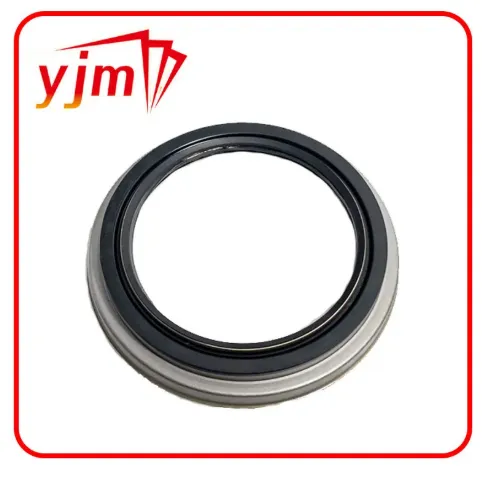Crankshaft Oil Seals: What They Are and Why They Matter in Engine Performance
Crankshaft oil seals are small yet crucial components in every internal combustion engine. Their primary job is to keep oil inside the engine while allowing the crankshaft to rotate freely. Over time, however, wear and tear on these seals can lead to oil leaks, reduced engine performance, and even serious damage if left unchecked. In this article, we’ll explore the role of the crankshaft oil seal, with a focus on both the front crankshaft seal (often called the front main seal) and the rear crankshaft seal. We’ll also clarify what a crank seal is and how to recognize when it's time for a replacement.

Understanding the Role of the Crankshaft Oil Seal
The crankshaft oil seal —commonly known simply as a crank seal—is designed to prevent engine oil from leaking out where the crankshaft exits the engine block. Since the crankshaft is constantly spinning while the engine is running, the seal must withstand high rotational speeds, pressure changes, temperature fluctuations, and oil exposure.
There are two main types of crankshaft seals in most engines:
Front crankshaft seal (or front main seal): Located at the front of the engine where the crankshaft connects to components like the timing gear or crank pulley.
Rear crankshaft seal: Located at the back of the engine, between the crankshaft and the transmission.
Both seals are made from durable rubber or polymer materials and are often spring-loaded to maintain tight contact with the rotating crankshaft.
Functions of a Crankshaft Seal:
Prevent engine oil from leaking out
Maintain oil pressure and lubrication efficiency
Protect the crankshaft and internal components from contamination
Help ensure long engine life and consistent performance
Front Crankshaft Seal: Common Issues and Replacement
The front crankshaft seal, also called the front main seal, is typically the first to wear out due to its position near belts, pulleys, and heat from the engine. When this seal begins to fail, it can lead to oil leaks around the front of the engine, commonly seen near the crankshaft pulley or harmonic balancer.
Signs of a Failing Front Main Seal:
Oil leaking from the lower front part of the engine
Oil spray on the timing belt or serpentine belt
Burning oil smell or visible smoke from oil dripping onto hot engine parts
Low oil levels over time without an obvious leak elsewhere
Replacement Tips:
Replacing the front crankshaft seal usually involves removing the crankshaft pulley or harmonic balancer and possibly the timing cover. While it’s not the most complex repair, it does require specific tools (like a seal puller and installer) and precise installation to avoid damaging the new seal.
Preventive Maintenance Advice:
Always inspect the front crank seal during timing belt or serpentine belt replacements.
Use OEM-quality seals to ensure proper fit and durability.
Replace belts and pulleys if they show signs of oil contamination.
Rear Crankshaft Seal: Hidden but Critical
The rear crankshaft seal is more difficult to access and replace because it's located between the engine and the transmission. Also known as the rear main seal, it serves the same purpose as the front seal—preventing oil from escaping where the crankshaft extends through the engine block. However, due to its hidden position, issues with the rear seal are often harder to detect until a significant leak occurs.
Symptoms of a Rear Crankshaft Seal Leak:
Oil dripping from the bell housing area of the transmission
Oil pooling under the center of the vehicle
Clutch contamination or slippage (in manual transmissions)
Engine oil level consistently dropping without an apparent leak source
Why Rear Main Seal Replacement Is a Big Job:
Unlike the front crank seal, replacing the rear crankshaft seal requires removing the transmission or engine in most vehicles. This labor-intensive process makes it one of the more expensive oil seal repairs.
Best Practices for Rear Main Seal Care:
Replace during clutch or transmission service if you're already accessing the area.
Keep crankcase pressure in check—excess pressure can force oil past seals.
Use high-quality synthetic oil to reduce heat and wear on internal components.
Choosing the Right Crank Seal and Ensuring a Leak-Free Engine
Whether you’re replacing a front main seal or a rear crankshaft seal, choosing the right seal is essential. OEM seals are often best, as they’re specifically designed for your engine's tolerances. However, high-quality aftermarket options made from advanced materials like Viton or PTFE can offer extended life and better heat resistance.
Key Considerations When Selecting a Crankshaft Seal:
Material: Rubber (NBR) is standard, but Viton and PTFE offer better durability.
Fitment: Always match your seal to the exact year, make, model, and engine type.
Installation Tools: Use seal drivers or press tools to avoid damaging the seal during installation.
Maintenance and Prevention Tips:
Monitor oil levels and check under your vehicle for leaks regularly.
Replace PCV valves and maintain proper crankcase ventilation to reduce pressure on seals.
Address any engine vibrations or misalignment issues that could cause seal wear.
The crankshaft oil seal might be small, but its role in maintaining engine integrity is significant. Whether it’s the front crankshaft seal, rear crankshaft seal, or simply referred to as the crank seal, proper care and timely replacement can save you from oil loss, poor performance, and major repair costs. With regular maintenance and attention to warning signs, you can ensure your engine runs clean, efficient, and leak-free for years to come.
-
High-Quality Seal 12x22x5 for Industrial & Automotive Use | YJM Seal
Uutiset Nov.25,2025
-
Seal 12x20x5: Precision Radial Shaft Seals for Industrial Reliability
Uutiset Nov.24,2025
-
Seal 12x18x5: Essential Guide to Specifications, Applications & Vendors
Uutiset Nov.24,2025
-
Understanding Seal 12 20 5: Applications, Specifications & Industry Insights
Uutiset Nov.23,2025
-
Durable Oil Seal 85x110x12 – Reliable Sealing Solutions for Industry
Uutiset Nov.23,2025
-
Durable and Precise Oil Seal 75x95x10 for Efficient Machinery | YJM Seal
Uutiset Nov.22,2025
-
Durable Oil Seal 75x100x10 for Reliable Industrial Performance | YJM Seal
Uutiset Nov.22,2025
Tuoteluokat















